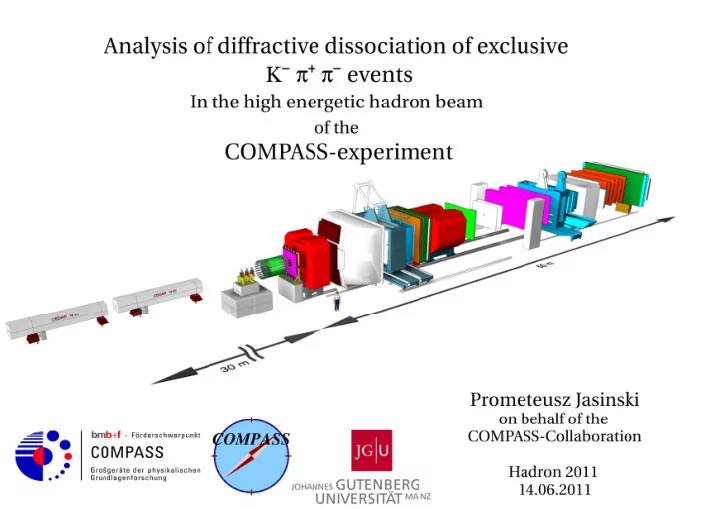

The qq model in a potential L s 2 s 1 Isospin I = ½ | us > | ds > | us > | ds >
Isospin = ½ light meson spectrum | us > | ds > | us > | ds > S = 0 S = 1 L 0 1 2 0 1 Energy = Mass [MeV/c²] K (1460) K 1 (B) K 0 *(1430) K 2 *(1430) K 1 (A) K* (892) Kaon (494)
Isospin = ½ light meson spectrum S = 0 S = 1 L 0 1 2 0 1 And many many more Energy = Mass [MeV/c²] K (1460) K 1 (B) K 0 *(1430) K 2 *(1430) K 1 (A) K* (892) Kaon (494) How do we produce those resonances?
Diffractive dissociation into Κ − π + π − Κ − Κ − π + X π − t' R,P p target p recoil
The measurement at COMPASS
The COMPASS Spectrometer 2008/2009
The COMPASS Spectrometer 2008/2009 Beam properties Beam properties Beam momentum 190 GeV/c Beam momentum 190 GeV/c Beam composition: Beam composition: π − : Κ − : p = 0.97 : 0.024 : 0.008 π − : Κ − : p = 0.97 : 0.024 : 0.008 � Up to 5 x 10 particles/s � Up to 5 x 10 particles/s beam
The COMPASS Spectrometer 2008/2009 CEDAR detectors for CEDAR detectors for beam particle identification beam particle identification
CEDAR particle identification Ce renkov D ifferential counter with A chromatic R ing Focus
CEDAR particle identification Difference of the cherenkov ring radii of a pion and a kaon is below 0.1 mm at 190 GeV/c beam momentum !
The COMPASS Spectrometer 2008/2009 Recoil proton detecto r Recoil proton detecto r around around 40 cm long lH2 target 40 cm long lH2 target
The COMPASS Spectrometer 2008/2009 Recoil proton detecto r Recoil proton detecto r around around 40 cm long lH2 target 40 cm long lH2 target
The COMPASS Spectrometer 2008/2009 RICH RICH
The COMPASS Spectrometer 2008/2009 π K p
Invariant mass distribution (K - π + π − ) Are those resonances decaying directly into 3 particles? ...
Invariant mass distributions (K - π + ) and ( π + π − )
RPD: determination of t' slopes data
RPD: determination of t' slopes data data
RPD: determination of t' slopes data fit data data
RPD: determination of t' slopes data fit data data
Determination of acceptance via MC
Acceptance in the Κ − π + π − invariant mass
Acceptance in the Gottfried Jackson frame
Acceptance in the Gottfried Jackson frame
Acceptance corrected partial wave analysis
Acceptance corrected partial wave analysis
The partial wave set
The total intensity
Spin totals
Spin totals
J P = 1 + waves
J P = 2 - waves
J P = 2 + waves
J P = 0 - waves
Summary and outlook Open strangness single diffractive mechanisms show resonant behavior � Those resonances are understood to be qq bar states with isospin ½ � The Κ − π + π − final state is shown to decay via substates � Tools of partial wave analysis (PWA) in the Ascoli approach are used to � determine resonances A mass independent acceptance corrected PWA fit was performed � Results are mostly in agreement with previous measurements but show � also also some interesting features For a final conclusion a mass dependent fit has to be performed � COMPASS is expected to double the number of events found in 2008 when � having reconstructed data of 2009
Thank you!
backup slides
Measured strange meson level scheme
resonances fitting the qq model
Resonances as listed in the PDG review
J P = 0 - waves
J P = 1 + M=1 waves
J P = 1 - waves
J P = 2 - waves
Recommend
More recommend